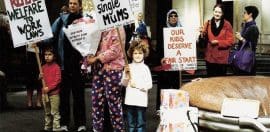ACOSS report uncovers rampant inequality in Australia pre-COVID

2 September 2020 at 5:43 pm
Charities say the data highlights the need to improve the nation’s welfare safety net
The top 20 per cent of Australian households have 90 times the wealth of the bottom 20 per cent, according to new research that shows inequality has widened in recent years.
The Australian Council of Social Services (ACOSS)/UNSW Sydney Poverty and Inequality Partnership Report used the latest available ABS data (2017-18) to analyse inequality in Australia pre-COVID-19.
Researchers hope to use it as a baseline against which to measure the impacts of the pandemic on income and wealth inequality.
The data showed that the incomes of households in the top 20 per cent were six times higher than those in the bottom 20 per cent, with this gap widening since 2015-16 (when the ratio was 1:5).
While average household wealth exceeded $1 million for the first time, the distribution of wealth in Australia was deeply skewed towards the top end of households.
The average wealth of the top 20 per cent ($3,255,000) was 90 times that of the lowest 20 per cent ($36,000).
Wealth inequality has grown rapidly in the past 15 years, with people in the top 20 per cent experiencing 68 per cent wealth growth compared with just six per cent for the bottom fifth of Australians.
ACOSS said given this inequality, and the fact it is likely to be exacerbated by COVID-19, it is vital that governments offer substantial support to welfare recipients.
CEO Dr Cassandra Goldie said timely action by the federal government to double the unemployment payment and create JobKeeper has temporarily raised the household incomes of people without paid work or at risk of losing their jobs.
“This report shows however that millions of people, pre-COVID, had very little by way of a financial buffer behind them,” Goldie said.
“There is a real danger in now expecting people to spend down on their already meagre savings, in order to survive. We need to support people’s incomes to prevent against dramatically widening both income and wealth inequality and the serious health, economic and social disadvantage that occurs.”
Noting that both the Coronavirus Supplement and JobKeeper Payment for full-time workers are scheduled to be cut by $150 a week from 28 September, Goldie said policies such as these will drive people further into financial deprivation.
She called for a “substantial, permanent increase” to the Jobseeker Payment to ensure those who cannot get paid work can meet household costs.
“Well-targeted and jobs-rich economic stimulus could prevent a further increase in unemployment. Permanently removing liquid assets tests and waiting periods to receiving income support are also vital,” she said.
“Applied together these measures will inoculate us against an increase in both income and wealth inequality and support our economic recovery from the pandemic.”
Other charities have used the report to also call for a boost to Australia’s social security safety net.
The CEO of Good Shepherd, Stella Avramopoulos, said this research demonstrated that the most vulnerable were being hit hardest by the pandemic.
She said people were overwhelmed, distressed and unable to see a way out of their growing financial pressures.
“We are calling for structural changes to the social welfare safety net, with new service models and cross-sector strategies to respond to the significant number of Australians now in financial distress,” Avramopoulos said.
“JobSeeker has been a critical aspect of this safety net and is needed to help build a financial wellbeing roadmap for Australians to recover.”
Anglicare Australia – which is a partner in the report – said the inequality highlighted in the data showed that cutting JobSeeker would make the issue much worse.
Executive director Kasy Chambers noted the charity’s recent report that found just 1.5 per cent of Australian rentals were affordable for people on JobSeeker.
“This report should shock all Australians. We are a rich country, yet the wealth gap is getting bigger and bigger,” Chambers said.
“A permanent increase to JobSeeker is the best way to help them bounce back.”
The full report can be seen here.







